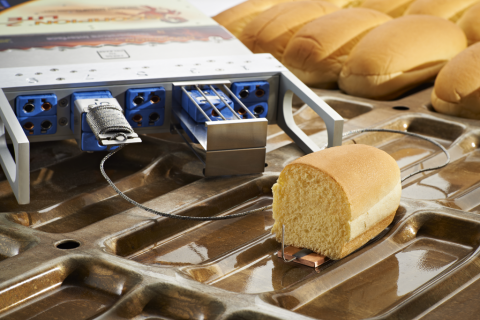Monitoring oven temperature is a crucial step in the commercial bread manufacturing process in order to control food quality and safety.
Reading Thermal has focused on measuring and understanding the commercial baking process for more than 25 years. We manufacture and support the SCORPION® 2 Profiling System, which has become a standard in the baking industry.
Why Measure Oven Temperature?
If you produce bread, artisan bread, biscuits, rolls, hamburger buns, cakes, or other bread products, you know oven temperature is responsible for physical and chemical reactions in dough/batter, and that temperatures that are too low or too high during baking can lead to changes in fermentation and humidity levels.
Too little heat can result in color that is too light. It can also cause the product structure to be too compact because few air bubbles developed in the baking process. This can produce a heavy and unappealing loaf with a pale or soft crust.
Too much heat coming from one direction in the oven can cause the bottoms of the loaves to burn before the crusts brown properly. The surface color will typically be too dark and the product may rise unevenly, resulting in a lot of surface cracks.
Measuring and controlling internal food temperature is also key to achieving food safety. The Food Safety Modernization Act (FSMA) requires commercial bakeries to validate and document process controls, or thermal kill steps, in an effort to reduce food borne pathogens, such as Salmonella spp, in ingredients and finished products.
How to Measure Oven Temperature
The Reading Thermal SCORPION® 2 Temperature Sensor Array is designed to measure temperature at product level, in fixed positions across the conveyor, and delivers a true representation of what your product is experiencing over time. Different types of pluggable sensors are available, including one designed for solid or tight mesh conveyors and one for open mesh conveyors.
The sensor array is connected to the SCORPION® 2 Data Logger and travels through the oven with your product(s), yielding a precise picture of temperature from side-to-side and end-to-end.
Case Studies:
- A Kaiser-roll bakery was running products through its tunnel oven for 16 minutes. The SCORPION® 2 Profiling System and Temperature Sensor determined that, after 10 minutes of baking time, the products had already reached an internal temperature of 200°F. The bakery was then able to shorten baking time and significantly increase capacity.
- Reading Thermal assisted a large bakery client that needed to determine the proper baking time for a wheat sandwich line it was baking in an 84-ft. continuous impingement tunnel oven with eight zones. By using the SCORPION® 2 Profiling System, internal dough temperatures were measured at 200°F at 74% of the 19:30 baking cycle rather than at the target rate of 85%. Overall oven temperatures were reduced an average of 15°F to slow internal baking, resulting in thousands of dollars of savings per month on natural gas.
If you are experiencing inconsistent product quality, temperature monitoring during your commercial bread manufacturing processes may be the solution you’re looking for. Call Reading Thermal’s headquarters in Sinking Spring, Pennsylvania at (610) 678-5890 Ext. 2, or contact us online to learn more about our innovative products.

